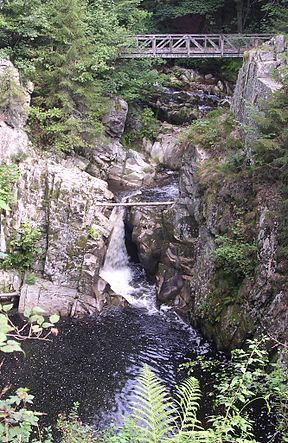- Cleurie river
-
Cleurie
Saut de la Cuve cascade on the CleurieOrigin Vosges Mountains Mouth Moselotte Basin countries France Length 19 km Avg. discharge 2.60 m³/s Basin area 77.5 km² The Cleurie or rupt de Cleurie is a river in the Lorraine in France, which flows in the Vosges department. It is a right tributary of the Moselotte, and thus a sub-tributary of the Rhine, via the Moselotte and the Moselle.
Contents
Geography
The Cleurie rises in the massif des Vosges, within the commune of Gérardmer from the confluence of two streams, the Corsaire and the Noir Rupt. It receives Liézey stream on its right, flows through Le Tholy, follows La Forge, Le Syndicat and Cleurie, then flows into the right bank of the Moselotte at Saint-Amé.
Its name is found in the denomination of the Communauté de communes de la Vallée de la Cleurie.
Hydrology
The flow rate of the Cleurie river has been measured at Cleurie over 38 years from 1967-2007. The measurement station is located five kilometres from the river's confluence with the Moselotte.[1] The watershed of the river there is 68 km², or about 88% of that at its mouth.
The river's average interannual flow rate or discharge at Cleurie is 2.39 m³/s.
The Cleurie river exhibits moderate seasonal variation in flow rate. High water occurs at the end of autumn and in winter, and are typified by monthly average instantaneous flow rates of between 2.82 and 3,54 m³/s, from November to March inclusive, with a maximum in December and January. Low water occurs in spring, from July to September inclusive, with a minimum monthly average flow rate of 1.02 m³/s in August. These monthly averages, however, hide more pronounced short-term veriations, especially since the flow rate varies from year to year.
At low water, the 3-year low instantaneous flow rate can drop to 0.290 m³/s, or 290 litres per second, which is hardly very severe.
Floods can be very significant for a small river endowed with a minimal basin. The maximum instantaneous flow rates over a 2-year and 5-year period (MIFR2 and MIFR5) measure 27 and 35 m³/s respectively. The MIFR10 measures 41 m³/s, the MIFR20 measures 47 m³/s and the MIFR50 measures 54 m³/s. These numbers correspond to about a third of the flooding flow rates of the Moselotte.
The maximum instaneous flow rate ever recorded at Cleurie over the entire period for which measurements exist was 51.7 m³/s on 25 January 1995, while the maximum ever recorded daily average value was 33.3 m³/s the same day. Comparing these values with the scale of the MIFR's listed above suggests that the floods of January 1995 were almost of the order of IMFR50 and quite exceptional, and that a flood of that size should occur on average once every 40 years.
All in all, the Cleurie is a very significant river. The runoff curve number in its watershed is 1,114 mm annually, which is more than three times higher than the overall average of France, and substantially more than the average of the whole French Moselle basin measured at 225 mm downstream of Metz. The specific flow rate is very high at 35.2 litres per second per square kilometre of basin.
See also
External links
- (French) SANDRE Website
- (French) Characteristic flow rates of the MoselottePDF
- (French) Characteristic flow rates of the CleuriePDF
References
Categories:- Vosges
- Rivers of Lorraine
- Moselle basin
Wikimedia Foundation. 2010.

